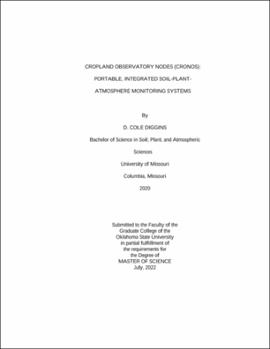| dc.description.abstract | In croplands the conditions within the soil-plant-atmosphere continuum can differ substantially from those at the closest available weather station, thus there is a need for monitoring stations optimized for deployment in cropland. Developed in response to this need, CRopland Observatory NOdeS (CRONOS) are portable in-situ, multi-sensor monitoring stations designed to monitor soil water content, green canopy cover (GCC), and atmospheric conditions. The objective of this study was to evaluate the performance of first-generation CRONOS systems on working farms. During the 2020-2021 winter wheat (Triticum aestivum) growing season, CRONOS stations were installed at three sites across Oklahoma, USA. Each station was equipped with a cosmic-ray neutron sensor to measure soil moisture, a camera to monitor GCC, and an all-in-one weather station. The soil moisture estimates were validated by comparison with distance- and depth-weighted average volumetric water content determined by soil sampling. The station’s GCC estimates were compared with the average GCC at the field scale. Meteorological data from the all-in-one weather stations were compared with observations from the Oklahoma Mesonet closest to each CRONOS site. The CRONOS stations accurately determined field-average soil water content, with a mean average difference (MAD) of 0.022 cm3cm-3 and a Nash-Sutcliffe Efficiency (NSE) of 0.756. The CRONOS GCC estimates showed greater discrepancies from the field-scale averages than did the soil water content estimates, with a MAD of approximately 12% and NSE of 0.43. These differences were most pronounced at one site where the crop growth near the station was less representative of the field as a whole. For atmospheric conditions, the level of agreement between the measurements of the CRONOS stations and the nearest Mesonet station varied, with NSE values ≥ 0.89 for measurements of air temperature, solar radiation, and atmospheric pressure but lower NSE values ranging from 0.34 – 0.87 for precipitation, relative humidity, and wind speed. Sensors were found to be reliable ≥ 98.4% percent of the time except for the cameras, for which 18.5% of the scheduled photos were missing. For subsequent generations of CRONOS stations, development efforts should focus on identifying more reliable and representative vegetation monitoring. | |
